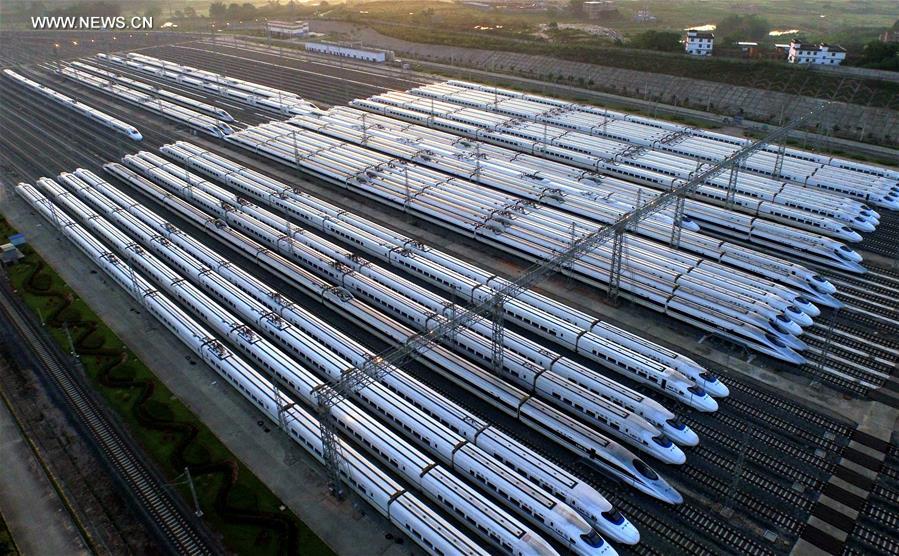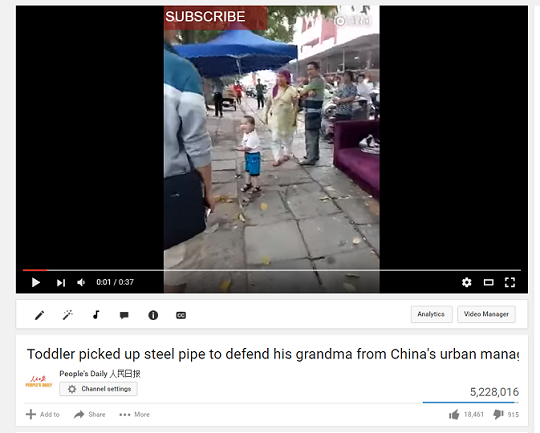


NANNING, May 18, 2016 (Xinhua) -- Photo taken on May 17, 2016 shows bullet trains in Nanning, capital of south China's Guangxi Zhuang Autonomous Region. Guangxi has had a high-speed rail mileage of over 1,700 kilometers since high-speed train introduced into Guangxi at the end of 2013. (Xinhua/Huang Xiaobang)
China put forth a more comprehensive plan for further expanding the country's rail network at a State Council meeting on Wednesday, presided over by Premier Li Keqiang.
The railway is China's key means of transportation and the lifeline of China's economy. The new plan aims for more balanced national railway construction, bringing greater accessibility to more parts of China.
It also aims to build a comprehensive transportation network together with road, water and air transportation.
Li stressed at the meeting that developing the rail sector remains of critical importance to China.
"At present, it is still a pressing task for us to expand China's railway network. It is the lifeline of the economy," Li said.
"When compared to developed countries similar in size, the length of China's operating railways is still not long enough, and railway construction is important for stabilizing economic growth and structural reform especially in central and western China," he said.
In 2008, China's National Development and Reform Commission issued a national railway plan, targeting an operating rail network of more than 120,000 km by the year 2020. The new plan approved on Wednesday is an upgrade of the 2008 plan.
According to the new plan, by the year 2020, China's railway network will reach a total of 150,000 km, of which about 30,000 km are high speed railway. Key measures include expanding the high-speed rail network to eight rail lines north to south, and eight lines east to west. Inter-city rails will also be gradually enhanced. Once achieved, rail travel between neighboring major and medium-sized cities will take no more than four hours.
Statistics from China's National Development and Reform Commission show that by 2015, China had an operating rail length of 121,000 km, of which 19,000 km were high-speed rail.
Over the past several years, high-speed railways have been developing rapidly, and have made transportation between big cities such as Beijing and Shanghai and lower-tier cities much more convenient.
The new plan also envisages boosting rail construction in central and western areas to achieve a more balanced development among regions.
During the meeting, Li said that more innovation is required in resolving problems encountered in rail development.
"We should seek innovation in developing China's railway project with both social and economic implication in mind, and this new plan should be planned well in advance with consideration not only given to demand, but also financial feasibility," Li said.
He also pointed out during the meeting that China Railway, China's national railway operator, needs to press ahead with self-reform and work hard to build a modern corporate system and finance through marketable ways so as to play a key role in the country's railway development.
Day|Week

 China's first intelligent security robot debuts in Chongqing
China's first intelligent security robot debuts in Chongqing A Total of 3,552 Subscribers Vanish In Two Days; YouTube Closes All Doors to Users’ Inquiries
A Total of 3,552 Subscribers Vanish In Two Days; YouTube Closes All Doors to Users’ Inquiries Out of this world! Futuristic UFO-shaped yacht has its own garden and a stunning underwater viewing deck
Out of this world! Futuristic UFO-shaped yacht has its own garden and a stunning underwater viewing deck An old tea house in Chengdu
An old tea house in Chengdu Furious Customer Crushes All the Buns from Vendor Just Because He Was Given the Wrong Flavor
Furious Customer Crushes All the Buns from Vendor Just Because He Was Given the Wrong Flavor 20 post-90s couples hold ’naked marriage‘ in E. China
20 post-90s couples hold ’naked marriage‘ in E. China Female official wearing traditional Han costume to promote local tourism
Female official wearing traditional Han costume to promote local tourism Over 12,000 Runners Seek Medical Care in S China’s Marathon
Over 12,000 Runners Seek Medical Care in S China’s Marathon Six Luxury Sports Cars Totaled after Fail Attempts to Cross China’s Most Perilous Highway Linking SW China’s Sichuan and Tibet
Six Luxury Sports Cars Totaled after Fail Attempts to Cross China’s Most Perilous Highway Linking SW China’s Sichuan and Tibet Incredible Transformation: “Witch Child”Whose Parents Left Him for Dead in Nigerian Makes Speedy Recovery
Incredible Transformation: “Witch Child”Whose Parents Left Him for Dead in Nigerian Makes Speedy Recovery